SINONASAL AND CRANIOFACIAL REGION AND CRANIAL NERVE V: INTRODUCTION AND GENERAL PRINCIPLES
IMAGING APPROACH
Techniques and Relevant Aspects
General Examination
Sinonasal computed tomography (CT) and magnetic resonance imaging (MRI) must include the axial and coronal sections as a routine. Coronal viewing is essential for the most routine “screening” sinus examination to the most complex study of the anterior skull base, orbit, and intracranial structures, most notably the cavernous sinus. Axial sections are the primary mode of image acquisition, and these source images must always be recorded. More specifically, they are often important for evaluating pathologic relationships in critical zones such as the orbital apex, pterygopalatine fossa, infratemporal fossa, posterior choanae, and nasopharynx. Sometimes, sagittal sections are necessary; however, these do not need to be produced routinely. Sagittal images are used to study the inner table of the frontal sinus, frontal recess region, and cribriform plate and the anterior wall and floor of the middle cranial fossa. Multidetector computed tomography (MDCT) of 16 slices or more makes it is simple to obtain a volume data set that can be routinely reconstructed as well as viewed with multiplanar reformation (MPR) tools that are of adequate quality MPR requirements.
Any study of the sinuses and facial region must be viewed and/or filmed at both soft tissue and bone windows. Intracranial and other extracranial pathology will mimic sinus disease and will be present incidentally in a significant number of patients. The soft tissues, including the brain, are not adequately evaluated when viewed on images done with a bone algorithm. This is a major shortcoming of coned beam CT since its low-contrast soft tissue and brain resolution is inherently very poor.
CT data sets should be obtained with 0.50- to 0.75-mm sections suitable for adequate resolution multiplanar reconstructions and/or reformations as discussed in Chapters 1 and 2. Contrast is used with CT depending on specific indications.1 The most common applications of CT for uncomplicated sinus and facial study are done without intravenous contrast. Specific CT protocols are presented in Appendix A.
MRI should be done with 3-mm sections and a field of view of 12 to 16 cm. All three orthogonal planes might be obtained, but axials and coronals suffice for most indications. T1- and T2-weighted images must be obtained, preferably in both planes. Fat suppression may be used but is unpredictably degraded by susceptibility artifacts in critical areas such as the cavernous sinus and orbital floor as discussed and shown in Chapters 1 and 3 (Figs. 1.3, 1.4, and 3.1). Non–fat-suppressed T1- and T2-weighted images before and after contrast are a safer choice, although the examination becomes lengthened. Intravenous contrast is used in most cases. Magnetic resonance (MR) protocols are presented in Appendix B.
Pros and Cons
CT and MRI are used for the majority of imaging in the sinonasal and facial region (Table 78.1). Plain films had been the standard study for evaluating patients with sinusitis, but their use has declined rapidly to almost nil in most practices in favor of CT.2 Plain radiographs, orthopantomography, and occlusal views remain the primary means of studying the teeth and mandible,3 although coned beam CT is replacing some of that routine dental imaging. Fluoroscopy is used to guide interventional procedures.
MRI has essentially replaced arthrography for evaluating internal derangements of the temporomandibular joint.
Ultrasound has no consistently useful role in sinonasal pathology, although it is used by some physicians.
Angiography is used occasionally in both diagnosis and treatment settings. Catheter angiography is necessary if angioarchitecture and temporal flow dynamics of a lesion are in question, although much of this usage will be replaced by 320 MDCT or its equivalent. If not, CT angiography and/or MR angiography will usually suffice.
Radionuclide studies, particularly single photon emission computed tomography (SPECT) gallium and bone scanning, are useful in selected cases of infectious disease. Fluorine-18 2-fluoro-2-deoxy-D-glucose positron emission tomography (FDG-PET) is assuming some role in infectious diseases. Catheter angiography is usually used following imaging studies, although it is occasionally the primary examination for problems such as intractable nosebleeds or a prelude to endovascular procedures. Specific radionuclide technique depends on the indications, and this is discussed in Chapter 5 and other relevant chapters.
TABLE 78.1
COMPARISON BETWEEN MAGNETIC RESONANCE IMAGING AND OTHER NONINVASIVE IMAGING TOOLS FOR HEAD AND NECK DISORDERS*
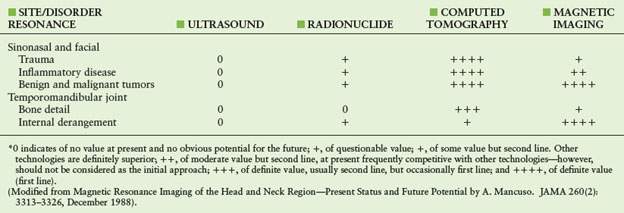
Specific Areas of Interest
Developmental Abnormalities
These are studied primarily with CT because bone detail is critical to diagnosis and three-dimensional planning or craniofacial reconstruction.4 These studies require CT done with as good a volumetric data set as possible at reasonable dose limits. These are done optimally on MDCT of 16 to 64 units. MR may be used to look for associated brain anomalies or for concerns of intracranial extension of congenital anomalies.
Inflammatory Disease
The evaluation of infectious and noninfectious inflammatory sinus disease used to begin with plain films. This approach has largely been abandoned, but plain films remain a rational and inexpensive screening tool. Most patients with persistent symptoms after a course of conservative management requiring imaging will get a CT. Screening examinations done to search for sinusitis as a cause for a fever of unknown origin, especially in immune-compromised patients, or as part of the workup prior to transplantation are typically handled with non–contrast-enhanced CT. Means of complying with reducing radiation exposure should be considered in pediatric screening studies, especially on MDCT units with the lesser number of slice partitions.5
The techniques used in the evaluation of patients who are potential candidates for endoscopic sinus surgery usually require a high-resolution volume acquisition and must be done in compliance with equipment used for image-guided surgery, if serving surgeons who use such guidance systems. Such protocols are outlined in Appendix A.
Complex inflammatory sinus disease, such as that posing a risk for orbital or intracranial complications, should be studied in the axial and coronal planes during infusion of intravenous contrast (Appendix A). MRI may be used as a supplemental study if intracranial pathology is likely but not demonstrated on CT.
Patients with a history of chronic sinus disease who have had sinonasal surgery such as frontal sinus obliteration will sometimes complain of persistent chronic pain. Using the single photon emission computed tomography (SPECT) radionuclide techniques, a combination of bone and gallium scanning can help exclude persistent sinus disease as a cause for the pain. Radionuclide techniques can also be used to follow the progress of therapy in invasive sinonasal and skull base fungal disease, although CT is more commonly used for this purpose.
Tumor
Patients with benign and malignant tumors often present with signs and symptoms identical to those of sinonasal inflammatory disease; therefore, these patients usually have had at least a non–contrast-enhanced CT by the time a tumor is confirmed by biopsy. A supplemental MRI is required most of the time in patients who have sinonasal cancer and in a smaller percentage of patients who have benign tumors.6–8 The MR in these cases is usually focused on clarifying specific issues that may critically alter patient management, including (a) the extent of intracranial involvement, (b) the extent of orbital invasion, (c) the presence and extent of perineural spread and possible cavernous sinus invasion, and (d) to determine whether sinus opacification is due to tumor invasion or obstruction. MR or CT may be most appropriate for follow-up of treated cancers; however, with MR, early bone invasion as a sign of recurrence or persistence may go unnoticed.6–8
If MRI, CT, or the clinical evaluation suggests a vasoformative lesion or highly vascular tumor, angiography may be done to confirm this impression. In hypervascular lesions, embolotherapy may be used as a definitive treatment or adjunct to surgical removal.
Trauma
CT has replaced plain films for evaluating patients at risk or with complex injuries. These CT studies are done with volume acquisition and MPR viewing and archiving. MR may be used to look for associated brain injury. Plain films may be used for confirmation of hardware placement and uncomplicated follow-up.
Controversies
Low-Cost “Screening” Sinus Computed Tomography
“Screening” sinus CT at a reduced cost has been suggested in the past. However, it is not practical since most of the time spent on a CT study is used for patient and computer setup, and obtaining some limited number of images makes no difference in throughput. Reduction in equipment, supplies, or technologist costs, therefore, cannot justify a reduced cost. This trend has likely died.
NORMAL ANATOMY
General Anatomic Description
The osteology of the face and sinonasal region is the critical feature as it relates to the orbit and central skull base; those general relationships are discussed in Chapter 3 (Figs. 44.2–44.11). The complex anatomic relationships of the medial wall of the nasal cavity and related sinuses are shown in Figures 78.1 through 78.5. Otherwise, the gross osteology of the face as it relates to specific pathologies is presented with those entities.9
The bones contributing to the maxillofacial region include the maxillary, frontal, nasal, lacrimal, ethmoid, zygomatic, palatine, and sphenoid bones (Fig. 44.11). The facial skeleton is completed by the mandible and temporomandibular joint, discussed in more detail in Chapter 96. The maxillofacial region may be divided into two basic portions: the midface including the nasal cavity and the lateral face. The midface includes the bones of the nose, medial orbit, and nasal cavity; specifically, this includes the medial portions of the frontal bones, the bodies, or labyrinthine portions of the ethmoid bones, the lacrimal bones, the nasal bones, and the medial portions of the maxilla. The lateral aspect of the face is composed of the lateral aspects of the maxilla, the zygoma, and the lateral portions of the frontal bones. The face is anchored to the central skull base by the attachment of the alveolar ridge and palatine bones to the pterygoid plates. The upper face is attached to the calvarium and anterior skull base by the frontal process of the maxilla, ethmoid roof, cribriform plate, and dura lining the anterior cranial fossa. The mesial depression in the anterior cranial fossa, corresponding to the superior surface or roof of the ethmoids, is sometimes called the fovea ethmoidalis.
The zygoma including its arch and frontal process anchors the lateral face to the skull base via the zygomatic process of the temporal bone and greater and lesser wings of the sphenoid. The lateral and midface are interconnected by the alveolar ridge inferiorly and the orbital floor of the maxilla and the orbital roofs of the frontal bone. Finally, the two halves of the midface are joined across the midline by the cribriform plate of the ethmoid and hard palate; the hard palate is formed by the palatine process of the maxilla and the horizontal process of the palatine bones. The midface is partially separated from the skull base by the superior and inferior orbital fissures (Chapter 44).
Several important fissures or canals exist either within or between the facial bones or their attachments to the skull base. The superior and inferior orbital fissures, infraorbital canal, and foramen rotundum are discussed in detail elsewhere as well with specific regard to orbital and visual function (Fig. 44.11). This discussion focuses more on the sphenopalatine foramen, pterygopalatine fossa, Vidian canal, incisive canal, and greater and lesser palatine foramina. All of these are important and will warrant additional consideration with respect to the pathology of the nasopharynx and central skull base as presented in Chapter 184.
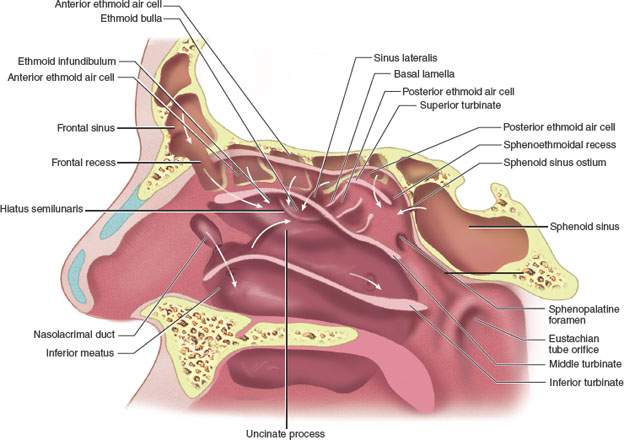
FIGURE 78.1. Anatomic diagram of the lateral wall of the nasal cavity. The diagram shows the relationship between the attachments of the turbinates and the paranasal sinus cavities. The arrows indicate common drainage pathways from the sinuses into the superior, middle, and inferior meatus.
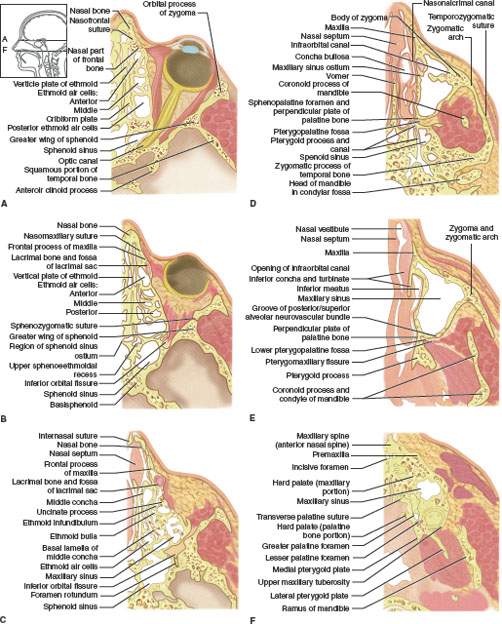
FIGURE 78.2. Line diagrams (A–F) of axial anatomy of the sinuses and nasal cavity to correlate with computed tomography images shown in Figure 78.3.
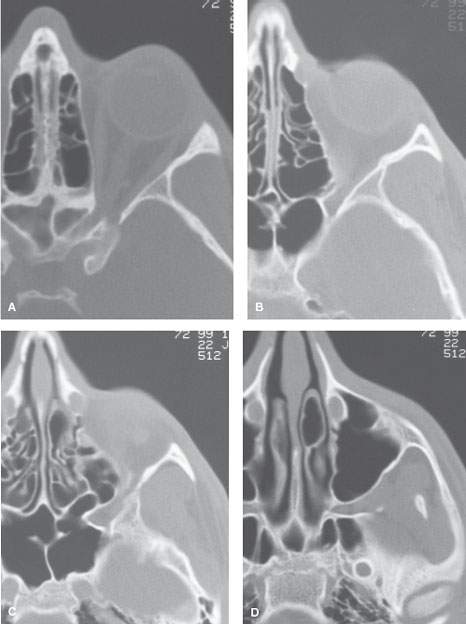
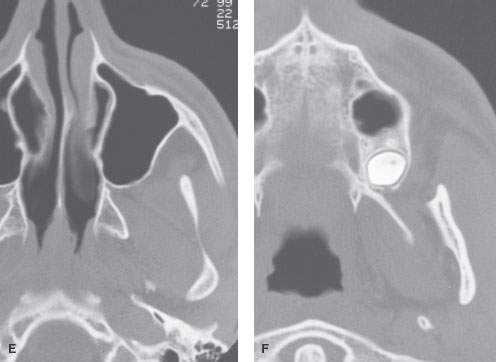
FIGURE 78.3. A–F: Computed tomography images filmed at bone windows to correlate with anatomic structures as noted in Figure 78.2A–F. (continued)
The pterygopalatine fossa is a fat-containing space bounded by the posterior wall of the maxillary sinus anteriorly, the pterygoid process posteriorly, and the perpendicular plate of the palatine bone medially; hence its name (Fig. 78.6). It is roughly pyramidal in shape, with its base lying superiorly continuous with the fat in the inferior orbital fissure. The fat in the pterygopalatine fossa also abuts the basisphenoid. The fossa tapers to its “apex” between the maxillary sinus and pterygoid process at about the lower third of these border-forming bones. The pterygopalatine fossa communicates with the posterior nasal cavity via the sphenopalatine foramen. The sphenopalatine foramen lies between the posterior attachments of the superior and middle turbinates; the lower rim of the foramen is the top of the perpendicular plate of the palatine bone, and its upper rim is formed by the basisphenoid (Fig. 78.6E). The entire lateral aspect of the pterygopalatine fossa is open to the infratemporal fossa via the pterygomaxillary fissure. This fissure opens into the retroantral fat pad; this fat pad is a cephalad extension of the buccal fat into the infratemporal fossa. Because of these anatomic relationships, the pterygopalatine fossa is at the crossroads between the facial skeleton, nasal cavity, middle cranial fossa, and deep spaces below the skull base. As such, it is an important conduit for the spread of pathology involving these vital structures.
The pterygoid or Vidian canal traverses the pterygoid process of the sphenoid bone opening into the upper pterygopalatine fossa just millimeters lateral to the sphenopalatine foramen; the Vidian canal connects the pterygomaxillary fossa to the horizontal segment of the carotid canal (Fig. 78.7). The greater and lesser palatine canals and foramina are conduits for the terminal portions of neurovascular bundles that descend from the pterygopalatine fossa as well as those ascending from the hard palate level. The respective canals can be seen distinctly along the lower one third of the pterygoid plates and their respective foramina at the level of the hard palate (Fig. 78.6D). The pterygoid fossa lies between the pterygoid plates, basically providing an attachment for the pterygoid muscles; the fossa sometimes contains prominent portions of the pterygoid venous plexus. The tiny pyramidal process of the palatine bone fills in the small fissure between the distal pterygoid process and plates and the maxilla. At the hard palate level, the incisive foramina (sometimes three holes are present) are a prominent landmark in the premaxilla. Horizontal and transverse sutures are frequently visible in the hard palate.
The mandible assumes a complex yoke shape as it articulates with the skull base while allowing for precise dental occlusion. Portions of the mandible include the U-shaped body of the mandible or its horizontal portion, the paired, vertically oriented rami, and the junctions between body and rami—the angle(s) of the mandible as shown in Chapter 96. The cranial end of each mandibular ramus has two processes: an anterior, nonarticulating, coronoid process and a posterior condylar process or condyle, the head of which articulates with the zygomatic portion of the temporal bone. These mandibular processes are separated by the mandibular notch.
There are some additional surface features of the mandible that are of clinical importance. A prominent ridge, the mylohyoid line, is evident along the inner surface of the body of the mandible (Fig. 78.8A). The mylohyoid muscle inserts along this line and provides the main support for the floor of the mouth. The mandibular foramen, with its small bony projection named the lingula, lies on the inner surface of the ramus and provides access to the mandible for the inferior alveolar artery, vein, and nerve (Fig. 78.8B,C). The canal runs horizontally below the molar teeth and divides beneath the premolars into incisive and mental canals. The mental canal terminates as the mental foramen on the buccal surface of the mandible. The incisive canal continues to the midline in some individuals. The mental foramina are paired ostia located on the anterior lateral aspect of the body of the mandible within 2 cm of the mental symphysis (Fig. 78.8D,E). On the inner surface of the mandible just opposite the mental symphysis are the superior and inferior genial tubercles, where the genioglossus and geniohyoid muscles attach to the lingual surface of the mandible. The temporomandibular joint connects the condylar process to the inferior margin of the temporal bone at the mandibular fossa.
Detailed Description of Specific Areas
Nasal Cavity and Functional Sinonasal Anatomic Relationships
Air flows into the nasal vestibule from the external nares. The nasal vestibule is a triangular spaced formed by the nasal bones and nasal cartilages. The mucosa of the nasal vestibule contains hair follicles and sweat glands and is comprised mainly of squamous epithelium. The remainder of the nasal cavity is lined with ciliated, respiratory columnar epithelium. The junction between the nasal vestibule and the nasal cavity is called the limen nasi (Fig. 78.9); it demarcates the transition from squamous to respiratory mucosa.
The nasal cavity is divided into three meati by roughly horizontally oriented nasal conchae (Figs. 78.1–78.5). The conchae are shelflike extensions of thin bone arising from the lateral and superior margins of the nasal cavity. The bony conchae together with their highly vascular mucosa and submucosa are called turbinates. The superior and middle turbinates arise from the ethmoid bone, while the inferior turbinate arises separately along the lateral nasal wall. A supreme turbinate arises from the ethmoid bone in some people but has little radiologic or functional significance. The upper three turbinates attach to the lateral nasal wall, all but the inferior via a basal lamella. The inferior, the middle, and the superior meatus are nasal air spaces lying inferior and medial to their corresponding respective turbinates. The nasal cavity is divided in the midline by the thin nasal septum. Much of the nasal septum is osseous, being formed by the vomer and perpendicular plate of the ethmoid, with the septum’s more anterior portion being cartilaginous (Fig. 78.5). The perpendicular plate continues superiorly to the cribriform plate, completing the separation of the nasal cavity into two, usually symmetric halves.
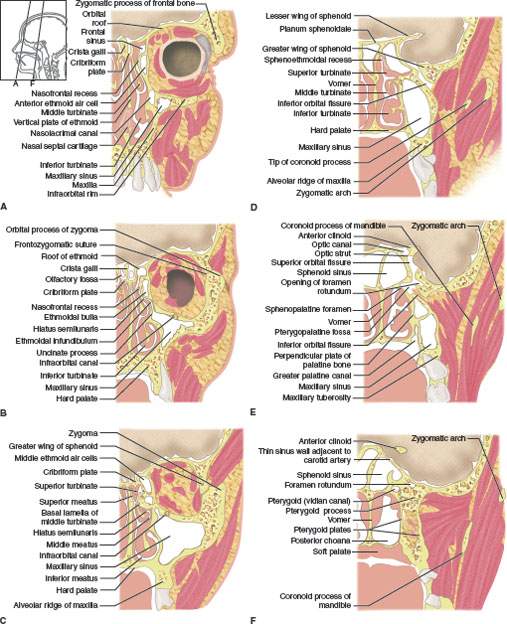
FIGURE 78.4. Line diagrams (A–F) of coronal anatomy of the sinuses and nasal cavity to correlate with images seen in Figure 78.5A–F.
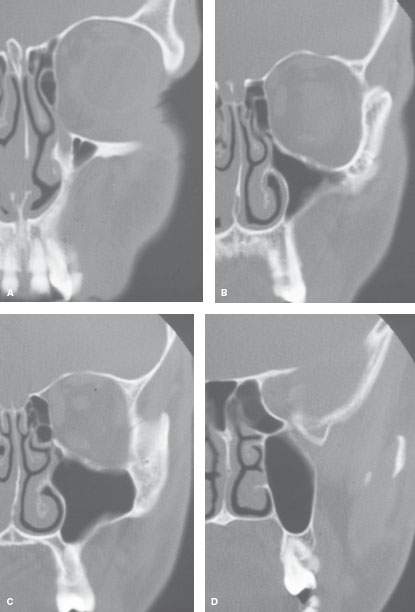
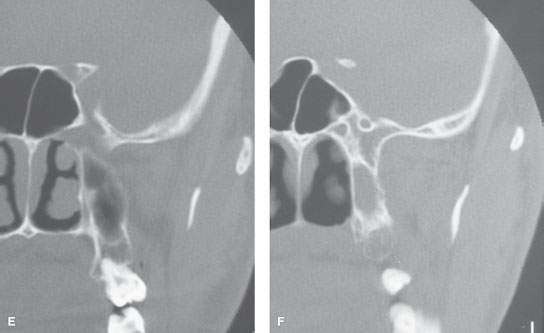
FIGURE 78.5. A–F: Coronal computed tomography images at bone windows to correlate with anatomic line diagrams seen in Figure 78.4. (continued)
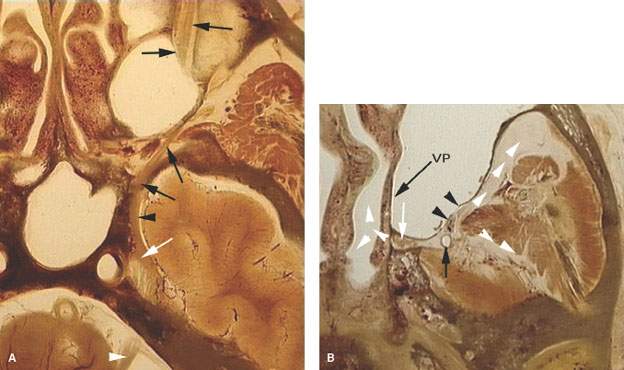
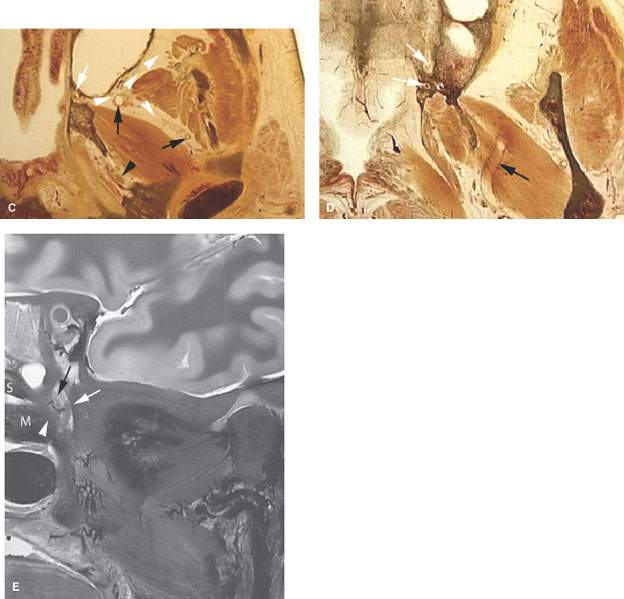
FIGURE 78.6. Anatomic sections illustrating the relationships of the pterygopalatine fossa to the central skull base, nasal cavity at the paranasal sinuses. A: The course of the second division of the trigeminal nerve from its most proximal cisternal segment as it emerges from the brain stem (white arrow). The nerve rootlets, after passing through the trigeminal cistern, form the trigeminal ganglion (white arrow). V2 then passes through the foramen rotundum (black arrowhead) to the upper pterygopalatine fossa and inferior orbital fissure region (proximal black arrows) and on to the infraorbital canal (distal black arrows). B: Anatomic section showing how the vertical plate (VP) of the palatine bone forms the anterior medial boundary of the pterygopalatine fossa. The pterygopalatine fossa then lies posterior to the junction of the vertical plate of the palatine bone and the posterior wall of the maxillary sinus (white arrow). The pterygopalatine fossa communicates with the nasal cavity posteriorly through the sphenopalatine foramen (white arrowheads) shown more medially. The distal maxillary artery branches extend along the posterior wall of the maxillary sinus (black arrow) along with distal ramifications of the posterior superior alveolar nerve. These structures frequently create areas of bone dehiscence (black arrows) in the posterior wall of the maxillary sinus. The more lateral white arrows show the communication between these spaces within the infratemporal fossa. C: The pterygopalatine fossa (white arrow) communicates from the pterygomaxillary fissure into the retroantral fat and masticator space portions of the infratemporal fossa (white arrowheads). The maxillary artery goes through the masticator space (black arrows), giving off branches such as the middle meningeal artery (more posterior black arrow). The third division of the trigeminal nerve lies within the masticator space (black arrowhead). D: An image through the hard palate showing the greater and lesser palatine foramina (white arrows). This image also shows how the maxillary artery crosses from medial to lateral through the pterygoid muscles within the masticator space (black arrow). E: An oblique view of the pterygopalatine fossa shows that it is bound superiorly by the base of the pterygoid plates (white arrow) and inferiorly and medially by the vertical plate of the palatine bone (white arrowhead). It contains the pterygopalatine ganglion (black arrow). It communicates with the nasal cavity at about the level of the middle turbinate mainly between the superior (S) and middle (M) turbinates.
The paired nasal bones, nasal spine or process of the frontal bone, and frontal processes of the maxillae make up the anterior aspect of the nasal cavity and nasal vestibule. These bones along with nasal cartilages form what is viewed externally as the nose.
The nasal cavity has a floor, root, and lateral walls. Each side, taken individually, also has a medial wall formed by the nasal septum. The floor of the nasal cavity is basically formed by the hard palate; individual parts include the premaxilla, the horizontal plate of the palatine bone (posteriorly), and the palatine processes of the maxillary bones (anteriorly). The lateral wall of the nasal cavity is formed by the ethmoid bone, maxilla, lacrimal bone, inferior concha, vertical plate of the palatine bone, and medial surface of the medial pterygoid plate. The nasal spine of the frontal bone and nasal bone form the more anterior (nasal) part of the roof of the nasal cavity. The remainder of the roof is formed by the cribriform plate and fovea ethmoidalis.
The lateral wall of the nasal cavity (medial wall of the maxilla) is not ossified in the gap between the perpendicular plate of the palatine bone and the maxilla and is referred to as the posterior fontanelle (Fig. 78.10); the wall here is made up of collagen sandwiched between the nasal mucosa and mucoperiosteum of the maxillary sinus. Lesions in this location, therefore, easily bulge the wall. This normal lack of bone can also be misinterpreted as bone destruction. This region can also include accessory maxillary ostia that can be a source of confusion for the endoscopic sinus surgeon.
The lateral wall of the nasal cavity is also the site of drainage for most of the paranasal sinuses. The general arrangement of the turbinates and meatus were presented earlier in this section. The middle meatus is the most complex and clinically relevant portion of the lateral wall of the nasal cavity. The complexity is due, in part, to the four basal lamellae of the ethmoid bone that subdivides the lateral wall and the pathways of sinus drainage (Figs. 78.1 and 78.11). These four lamellae include the uncinate process, the ethmoidal bulla, the attachment of the middle concha, and the attachment of the superior concha. A fifth basal lamella, the attachment of the supreme turbinate, may also be present.
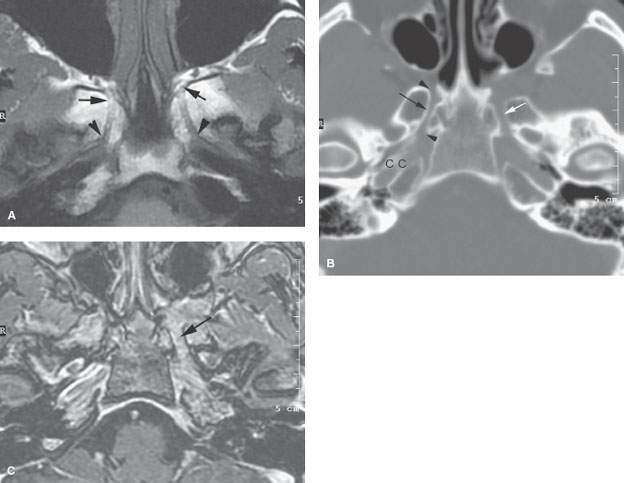
FIGURE 78.7. A series of images showing the relationship of the pterygoid (Vidian) canal to the pterygopalatine fossa. A: Magnetic resonance (MR) image through the central skull base showing the Vidian canal from its opening at the pterygopalatine fossa (black arrows) to its communication with the carotid canal (arrowheads). B, C: Computed tomography (CT) and contrast-enhanced images, respectively. In (B), the CT image shows the normal right Vidian canal (black arrow) as it extends (black arrowheads) from the pterygopalatine fossa to the carotid canal (CC). The left Vidian canal is widened due to spread of nasopharyngeal cancer (white arrowhead). In (C), MR of the same patient shows the marked enlargement of the Vidian canal on the left (arrow).
Stay updated, free articles. Join our Telegram channel

Full access? Get Clinical Tree








